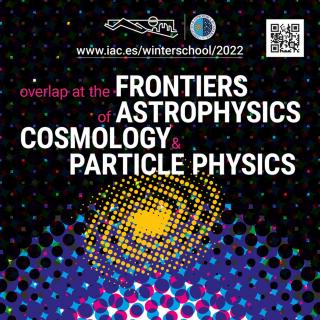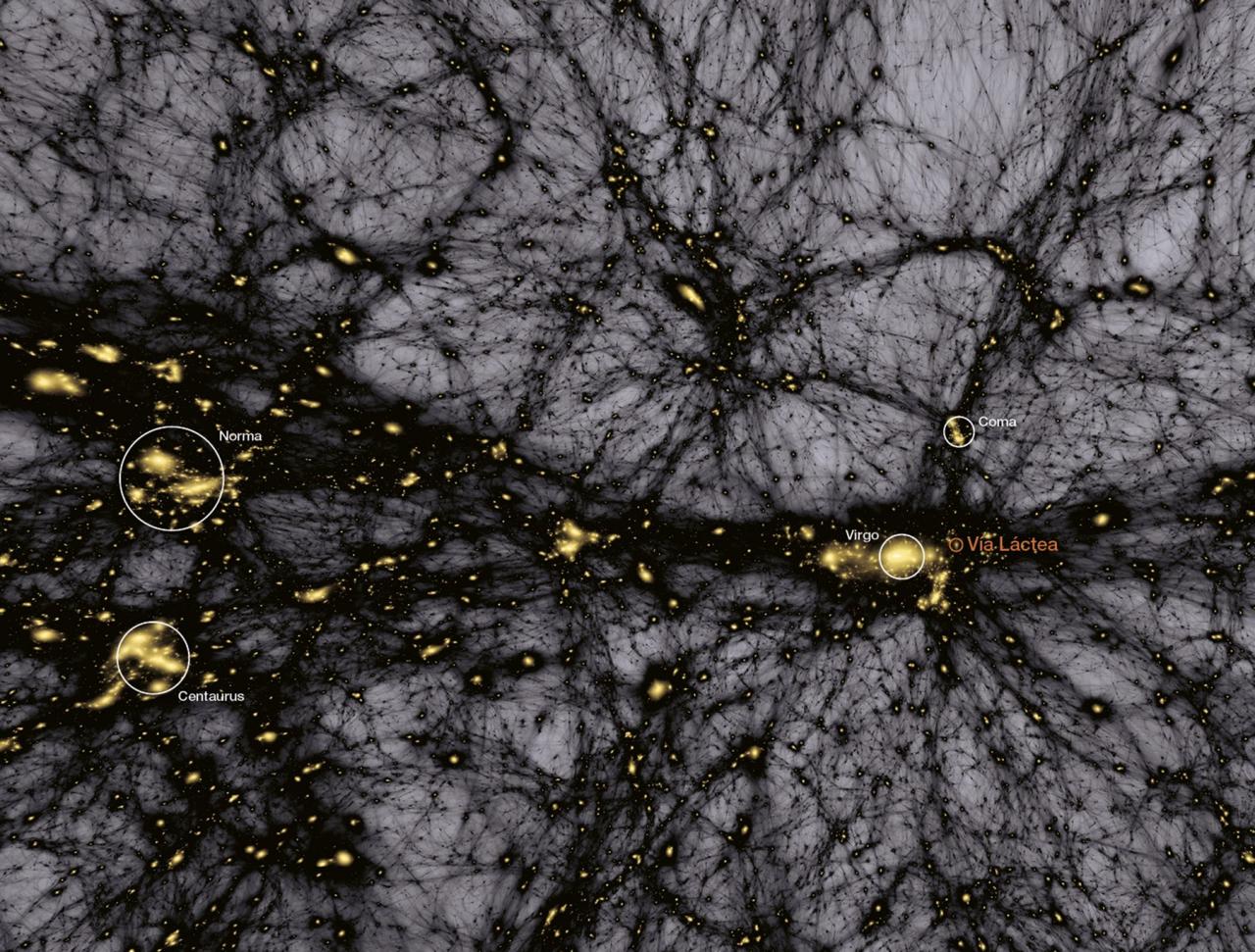Subvenciones relacionadas:
General
El Fondo Cósmico de Microondas (FCM) contiene la información estadística de las semillas primigenias que han dado lugar a la formación de todas las estructuras en el Universo. Su contrapartida natural en el Universo local es la distribución de las galaxias que surgen como resultado del crecimiento gravitatorio de aquellas fluctuaciones de densidad primigenias. La caracterización de la distribución de inhomogeneidades a gran escala en el Universo local proporciona una herramienta muy poderosa, y complementaria al FCM, para determinar el origen y el contenido energético del Universo, el ritmo de expansión del mismo durante la evolución cósmica, los detalles del proceso de formación de todas las estructuras a gran escala que observamos en el Universo hoy día. Esta es la página web del grupo de Cosmología con trazadores de la Estructura a Gran Escala (LSS de sus siglas en inglés), en el IAC.
Miembros
Resultados
- eBOSS: análisis cosmológico de los datos de cuásares. Marcos Pellejero Ibañez and F. S. Kitaura participaron en la construcción de la likelihood y en el análisis de los parámetros cosmológicos (including as coauthors Kitaura & Pellejero Ibañez: 2018MNRAS.473.4773A).
- EUCLID: proyecto comparativo de códigos para generar catálogos de galaxias sintéticos, donde se demostró la precisión y eficiencia de PATCHY (including as coauthors Balaguera-Antolínez, Kitaura & Pellejero Ibañez: https://arxiv.org/abs/1806.09497, https://arxiv.org/abs/1806.09477, https://arxiv.org/abs/1806.09499)
- Desarrollo de un método para asignar el bias para estudios de estructura a gran escala (Balaguera-Antolínez, Kitaura, Pellejero Ibañez et al 2018: https://arxiv.org/abs/1806.05870)
- Presentación del proyecto UNITSIM para proporcionar modelos teóricos para comparar con observaciones DESI y EUCLID (including as coauthors Kitaura & Pellejero Ibañez:http://www.unitsims.org/ https://arxiv.org/abs/1811.02111)
- Presentación del código BARCODE (Bos, Kitaura & Weygaert 2018: https://arxiv.org/abs/1810.05189, http://adsabs.harvard.edu/abs/2018ascl.soft10002B)
Actividad científica
Publicaciones relacionadas
-
Planck intermediate results. V. Pressure profiles of galaxy clusters from the Sunyaev-Zeldovich effectTaking advantage of the all-sky coverage and broadfrequency range of the Planck satellite, we study the Sunyaev-Zeldovich (SZ) and pressure profiles of 62 nearby massive clusters detected at high significance in the 14-month nominal survey. Careful reconstruction of the SZ signal indicates that most clusters are individually detected at least outDelabrouille, J. et al.
Fecha de publicación:
22013 -
Planck intermediate results. VIII. Filaments between interacting clustersContext. About half of the baryons of the Universe are expected to be in the form of filaments of hot and low-density intergalactic medium. Most of these baryons remain undetected even by the most advanced X-ray observatories, which are limited in sensitivity to the diffuse low-density medium. Aims: The Planck satellite has provided hundreds ofZacchei, A. et al.
Fecha de publicación:
22013 -
The Baryon Oscillation Spectroscopic Survey of SDSS-IIIThe Baryon Oscillation Spectroscopic Survey (BOSS) is designed to measure the scale of baryon acoustic oscillations (BAO) in the clustering of matter over a larger volume than the combined efforts of all previous spectroscopic surveys of large-scale structure. BOSS uses 1.5 million luminous galaxies as faint as i = 19.9 over 10,000 deg2 to measureKauffmann, Guinevere et al.
Fecha de publicación:
12013 -
The Ninth Data Release of the Sloan Digital Sky Survey: First Spectroscopic Data from the SDSS-III Baryon Oscillation Spectroscopic SurveyThe Sloan Digital Sky Survey III (SDSS-III) presents the first spectroscopic data from the Baryon Oscillation Spectroscopic Survey (BOSS). This ninth data release (DR9) of the SDSS project includes 535,995 new galaxy spectra (median z ~ 0.52), 102,100 new quasar spectra (median z ~ 2.32), and 90,897 new stellar spectra, along with the dataSheldon, Erin et al.
Fecha de publicación:
122012 -
Structure of Abell 1995 from optical and X-ray data: a galaxy cluster with an elongated radio haloContext. Abell 1995 is a puzzling galaxy cluster hosting a powerful radio halo, but it has not yet been recognized as a obvious cluster merger, as usually expected for clusters with diffuse radio emission. Aims: We aim at an exhaustive analysis of the internal structure of Abell 1995 to verify that this cluster is really dynamically relaxed, asBoschin, W. et al.
Fecha de publicación:
112012 -
Dark Matter, Magnetic Fields, and the Rotation Curve of the Milky WayThe study of the disk rotation curve of our Galaxy at large distances provides an interesting scenario for us to test whether magnetic fields should be considered as a non-negligible dynamical ingredient. By assuming a bulge, an exponential disk for the stellar and gaseous distributions, and a dark halo and disk magnetic fields, we fit the rotationRuiz-Granados, B. et al.
Fecha de publicación:
82012 -
The clustering of galaxies in the SDSS-III Baryon Oscillation Spectroscopic Survey: cosmological implications of the large-scale two-point correlation functionWe obtain constraints on cosmological parameters from the spherically averaged redshift-space correlation function of the CMASS Data Release 9 (DR9) sample of the Baryonic Oscillation Spectroscopic Survey (BOSS). We combine this information with additional data from recent cosmic microwave background (CMB), supernova and baryon acoustic oscillationSánchez, Ariel G. et al.
Fecha de publicación:
92012 -
Cosmological constraints on nonstandard inflationary quantum collapse modelsWe briefly review an important shortcoming—unearthed in previous works—of the standard version of the inflationary model for the emergence of the seeds of cosmic structure. We consider here some consequences emerging from a proposal inspired on ideas of Penrose and Diósi [R. Penrose, The Emperor’s New Mind. Concerning Computers, Minds and Laws ofLandau, Susana J. et al.
Fecha de publicación:
62012 -
Planck intermediate results. I. Further validation of new Planck clusters with XMM-NewtonWe present further results from the ongoing XMM-Newton validation follow-up of Planck cluster candidates, detailing X-ray observations of eleven candidates detected at a signal-to-noise ratio of 4.5 S/N 5.3 in the same 10-month survey maps used in the construction of the Early SZ sample. The sample was selected in order to test internal SZPlanck Collaboration et al.
Fecha de publicación:
72012 -
The Orientation of Disk Galaxies around Large Cosmic VoidsUsing a large sample of galaxies from the the seventh data release of the Sloan Digital Sky Survey (SDSS-DR7), we have analyzed the alignment of disk galaxies around cosmic voids. We have constructed a complete sample of cosmic voids (devoid of galaxies brighter than Mr - 5log h = -20.17) with radii larger than 10 h -1 Mpc up to redshift 0.12. DiskVarela, J. et al.
Fecha de publicación:
12012 -
Quantifying the coherent outflows of galaxies around voids in the SDSS DR7We report the detection, with a high level of confidence, of coherent outflows around voids found in the seventh data release of the Sloan Digital Sky Survey (SDSS DR7). In particular, we developed a robust ⟨|cos θ|⟩ statistical test to quantify the strength of redshift-space distortions (RSD) associated with extended coherent velocity fields. WePatiri, S. G. et al.
Fecha de publicación:
52012 -
Halo concentrations in the standard Λ cold dark matter cosmologyWe study the concentration of dark matter haloes and its evolution in N-body simulations of the standard Λ cold dark matter (ΛCDM) cosmology. The results presented in this paper are based on four large N-body simulations with ˜10 billion particles each: the Millennium-I and -II, Bolshoi and MultiDark simulations. The MultiDark (or BigBolshoi)Prada, Francisco et al.
Fecha de publicación:
72012 -
Environmental effects on the bright end of the galaxy luminosity function in galaxy clustersContext. The dependence of the luminosity function (LF) of cluster galaxies on the evolutionary state of the parent cluster is still an open question, in particular concerning the formation/evolution of the brightest cluster galaxies. Aims: We study the bright part of the LFs of a sample of very unrelaxed clusters ("DARC" clusters showing evidenceBarrena, R. et al.
Fecha de publicación:
42012 -
Abell 1758N from an optical point of view: new insights on a merging cluster with diffuse radio emissionContext. The mechanisms producing the diffuse radio emission in galaxy clusters, and in particular their connection with cluster mergers, are still debated. Aims: We seek to explore the internal dynamics of the cluster Abell 1758N, which has been shown to host a radio halo and two relics, and is known to be a merging bimodal cluster. Methods: OurBoschin, W. et al.
Fecha de publicación:
42012
Charlas relacionadas
No se han encontrado charlas relacionadas.Congresos relacionados
-
 XXXIII Escuela de Invierno de Canarias sobre Astrofísica: Física de Astropartículas y CosmologíaLa XXXIII Canary Islands Winter School of Astrophysics, organizada por el Instituto de Astrofísica de Canarias (IAC), se centra en la Física de Partículas y la Cosmología. La escuela, que se celebrará"Salón de actos" del Museo de la Ciencia y el Cosmos (MCC) Avda. Los Menceyes 70 38205 San Cristóbal de La LagunaEspañaFecha-Anteriores
XXXIII Escuela de Invierno de Canarias sobre Astrofísica: Física de Astropartículas y CosmologíaLa XXXIII Canary Islands Winter School of Astrophysics, organizada por el Instituto de Astrofísica de Canarias (IAC), se centra en la Física de Partículas y la Cosmología. La escuela, que se celebrará"Salón de actos" del Museo de la Ciencia y el Cosmos (MCC) Avda. Los Menceyes 70 38205 San Cristóbal de La LagunaEspañaFecha-Anteriores



